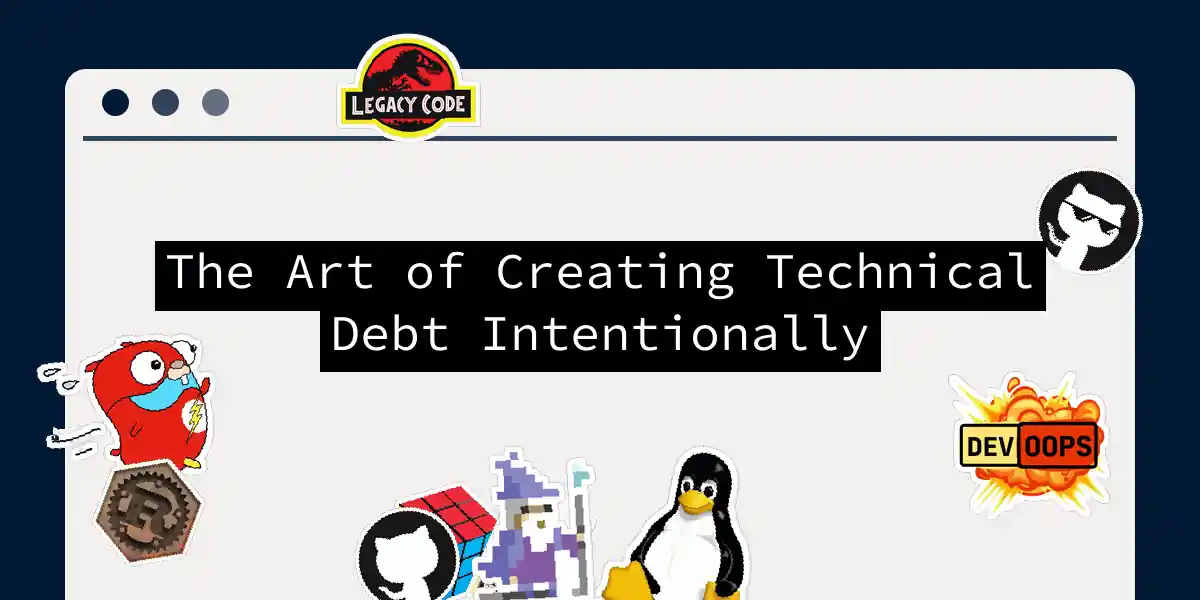Picture this: you’re racing against a deadline that’s approaching faster than a caffeinated squirrel. Your team could build the “perfect” solution… in about three weeks. Or you could ship a functional version tomorrow by strategically cutting corners. Welcome to the art of intentional technical debt—where smart shortcuts become superpowers rather than sins. Unlike accidental code messes born from midnight coding sessions (#Guilty), intentional technical debt is a conscious trade-off—a calculated gamble that buys you runway today while scheduling cleanup for tomorrow. Think of it as taking out a mortgage instead of maxing out credit cards. Let’s explore how to wield this double-edged sword without bleeding productivity.
The Debt Quadrant: Your Strategic Compass
Not all debt is created equal. Drawing from Martin Fowler’s quadrant model, our decision framework looks like this:
Where you land depends on two factors:
- Intent: Did you choose this path (deliberate) or stumble into it (inadvertent)?
- Prudence: Was the decision grounded in data (prudent) or desperation (reckless)?
The golden quadrant? Deliberate + Prudent. Here’s how to live there:
Crafting Debt Like an Architect: 5 Tactics
1. Debt With Documentation Handcuffs
Never create debt without a “repayment plan” tattooed in your codebase. Here’s what disciplined debt looks like in Python:
def process_payments(users):
# TECH-DEBT-2025-Q4: Batch processing for >1000 users
# Temporary workaround for Shopify integration
# Scheduled refactor: 2025-12-01 (see Jira TD-42)
if len(users) > 1000:
return分批处理(users) # Shh... this is temporary!
# ... rest of logic
Why this works:
- Explicit
TECH-DEBTtag in comments - Jira ticket reference
- Hard deadline (
2025-12-01) - Context about why the debt exists
2. The ROI Triage Framework
Not all debt deserves repayment. Use this risk-vs-reward filter:
| Debt Type | Business Impact | Fix Cost | Priority |
|--|--|--|--|
| Broken Checkout | Critical ($$$) | 3 days | P0 |
| Slow Report Export | Moderate ($) | 2 weeks | P2 |
| Ugly CSS | Low (-) | 1 week | P4 |
Rule of thumb: If fixing costs more than the business loses from keeping it, table it. Otherwise—pay up!
3. The “Debt Bond” Strategy
Treat tech debt like financial bonds with maturity dates. When implementing quick fixes:
- Add
// MATURITY-DATE: 2025-11-30to your code - Create automated alerts 5 days before maturity
- Refactor becomes non-negotiable (like paying taxes)
4. Debt-Driven Development (DDD)
Yes, that’s a real acronym I just made up. During sprint planning:
1. **Identify**: "We can deliver Feature X in 2 days with temporary solution Y"
2. **Quantify**: "This creates 3 points of UI debt"
3. **Schedule**: "Repayment scheduled sprint 24.16"
This transforms debt from a dirty secret to a tracked resource.
5. The Debt Amnesties
Schedule quarterly “debt forgiveness sprints”:
- Freeze feature development
- Dedicate 70% capacity to debt repayment
- Host a “Worst Code Contest” (winner gets tacos)
- Delete deprecated code with ceremonial
rm -rf
When Intentional Debt Goes Wrong: 3 Rescue Plans
Even Picasso had paint spills. Damage control tactics:
Scenario: Your “temporary” payment hack became permanent
Fix:
# Find all debt markers
git grep -n "TECH-DEBT" -- *.py
# Output:
# payment_service.py:42:# TECH-DEBT-2025-Q4
Scenario: Repayment deadline missed
Mitigation: Automate debt tracking with:
# debt_monitor.py
import datetime
from code_analysis import scan_comments
def alert_expired_debt():
today = datetime.date.today()
for debt in scan_comments(keyword="TECH-DEBT"):
if debt.due_date < today:
slack_alert(f"🔥 Debt overdue: {debt.file}:{debt.line}")
Scenario: Business wants to postpone repayment
Negotiation Tactic: Show the compounding interest:
“Delaying this refactor will cost 3 extra hours/week in bugs. That’s $15k/month in dev time.”
The Zen of Prudent Debt: 3 Mindset Shifts
- Debt as Controlled Burn
Like forest management, small intentional fires prevent catastrophic wildfires. A 2-day shortcut that prevents missing a $500k deal? That’s not debt—it’s leverage. - The 20% Rule
Cap tech debt at 20% of your development capacity. If your velocity is 50 points/sprint, allocate ≤10 points to debt repayment. - Debt Transparency = Trust
Public dashboards build credibility:
Conclusion: Becoming Debt Artists
Intentional technical debt isn’t about cutting corners—it’s about strategic corner-cutting with architectural intent. By treating debt like a financial instrument (not a crime), you transform from a hacky developer into a software strategist. Remember: Debt without documentation is sabotage. Debt without a repayment plan is betrayal. But debt with intention? That’s the mark of a pragmatic engineer. Now go ship that feature—you’ve earned your interest.
